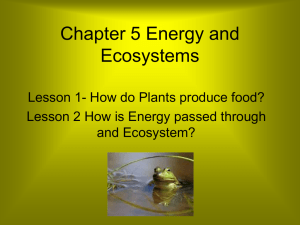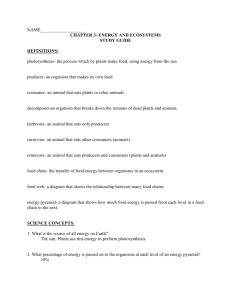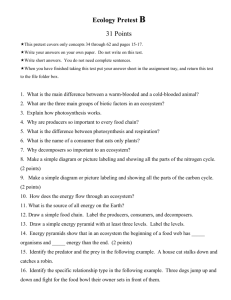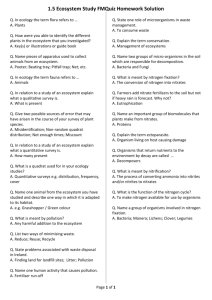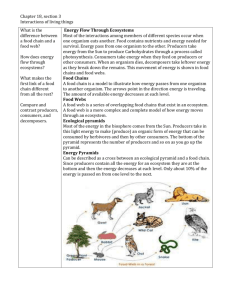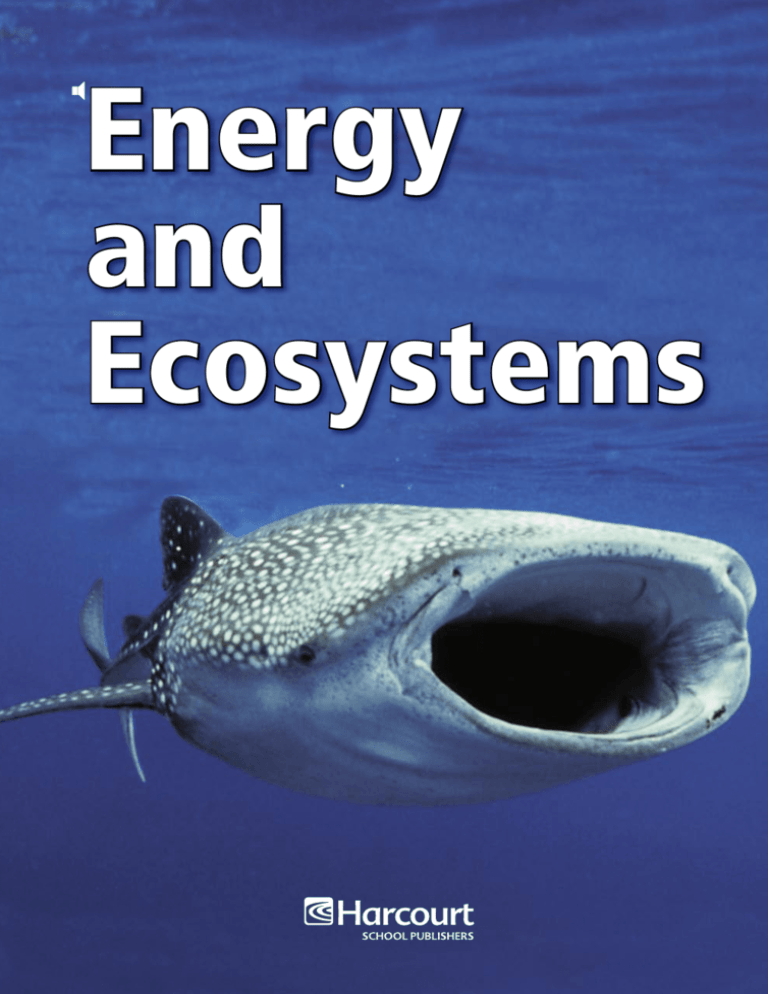
Energy
and
Ecosystems
Copyright © by Harcourt, Inc.
All rights reserved. No part of this publication may be reproduced or transmitted in any
form or by any means, electronic or mechanical, including photocopy, recording, or
any information storage and retrieval system, without permission in writing from the
publisher.
Requests for permission to make copies of any part of the work should be addressed to
School Permissions and Copyrights, Harcourt, Inc., 6277 Sea Harbor Drive, Orlando, FL
32887-6777. Fax: 407-345-2418.
HARCOURT and the Harcourt Logo are registered trademarks of Harcourt, Inc.,
registered in the United States of America and/or other jurisdictions.
Printed in the United States of America
ISBN 0-15-343869-X
1 2 3 4 5 6 7 8 9 10
179
10 09 08 07 06 05 04
Energy and
Ecosystems
Lesson 1
How Do Plants Produce Food?. . . . . . . . . . . . . . . . . . . . . 2
Lesson 2
How Does Energy Pass Through an Ecosystem? . . . . . . 10
Orlando Austin New York San Diego Toronto London
Visit The Learning Site!
www.harcourtschool.com
1
VOCABULARY
VOCABULARY
transpiration
photosynthesis
chlorophyll
producer
consumer
How Do
Plants
Produce
Food?
Transpiration is the loss of
water through leaves.
2
Photosynthesis is the
process plants use to make
food. The process uses light
energy, water, and carbon
dioxide.
Chlorophyll is the green coloring in plants.
It helps the plant use the sun’s light energy.
A producer is a living thing that makes its own food. Plants
are producers. Consumers are animals that eat plants, other
animals, or both.
3
READING FOCUS SKILL
MAIN IDEAS AND DETAILS
The main idea is what the text is mostly about. Details
are pieces of information that tell about the main idea.
As you read, look for details about how plants make
and store food.
Plant Parts
The basic parts of plants are roots, stems, leaves, and
flowers. Roots anchor a plant in the ground. They also take
in water and nutrients. Tubes in the roots carry water and
nutrients to the stems.
Both roots and stems have
tubes running through
them. C
tubes
tubes
tubes
tubes
4
Stems support the plant
and allow the leaves to reach
sunlight. Stems also contain
D Veins in a leaf
connect to the
tubes that carry water and
tubes in the
nutrients. Other tubes in
stem.
stems carry food.
The main job of leaves is to
make food. Most leaves have
several layers of cells. The outer layer keeps the leaf from
drying out. The bottom of a leaf has many small openings.
These are called stomata (STOH•muh•tuh).
Stomata open during the day. This lets the leaf take in
carbon dioxide to make food. At night, the stomata close. This
keeps the plant from drying out. The loss of water through the
stomata is called transpiration.
Tell what the stomata in leaves do.
stomata
D When stomata
are open, they
let in carbon
dioxide. They
close at night to
keep water in.
5
Photosynthesis
Plants make food they need by photosynthesis. The
process uses water, carbon dioxide, and sunlight.
Sunlight provides energy
for plants to make food.
Plants take in carbon
dioxide from the air.
The food made by the plant
is stored in leaves, stems,
seeds, and roots.
6
After making
food, the leaves
release oxygen.
Most plant cells contain chlorophyll.
Chlorophyll helps a plant use light energy
to make food. It also makes plants green.
Photosynthesis begins when sunlight hits
the plant cells. The sun’s energy is taken in.
This energy causes water and carbon dixoide
to make sugar. Sugar is the food that plants
need to live and grow.
Oxygen is given off during photosynthesis.
The oxygen is passed into the air through
the stomata. The diagram shows how
photosynthesis works.
Explain what a plant needs in order
for photosynthesis to take place.
Chlorophyll takes energy from
sunlight. The plant needs this
energy to make food.
Plant roots take in water,
which is needed for
photosynthesis.
7
Producers and Consumers
All living things need energy to live and grow. That energy
comes from food. Plants are called producers because they
produce, or make food.
Animals can’t make food. But they still need energy to live
and grow. When animals eat plants, the animals get energy
stored in the plants. The word consume means “to eat.” So we
call animals that eat plants consumers.
These bison get energy
from eating plants. The
plants are producers and
the bison are consumers.
Without the plants the
bison could not live.
8
You and every animal need plants. Even animals that eat
only other animals need plants. Without plants, animals such
as deer and rabbits would starve. Then animals such as wolves,
which eat deer and rabbits, would have nothing to eat. They
would starve, too.
The energy from sunlight moves from plants, to animals that
eat plants. Then it moves to animals that eat other animals.
Without sunlight, nearly every living thing on Earth would die.
Tell the difference between a producer
and a consumer.
Review
Complete this main idea sentence.
1. All organisms need ______ in order to live and
grow.
Complete these detail statements.
2. Tubes in the roots of plants carry water and
nutrients to the ______ of plants.
3. The underside of a leaf has many small openings
called ______.
4. Only plant cells with structures called ______ can
make food.
5. ______ is given off as the result of photosynthesis.
9
2
VOCABULARY
ecosystem
herbivore
carnivore
food chain
decomposer
food web
energy pyramid
How Does
Energy Pass
Through an
Ecosystem?
An ecosystem is all the
living things in an area. It is
also the environment in which
they live. This picture shows
part of a pond ecosystem.
10
An herbivore is an
animal that eats plants. A
carnivore is an animal that
eats animals. This wolf is a
carnivore.
A food chain is the
transfer of food energy in an
ecosystem. This caribou gets
its food energy by eating
moss.
A decomposer is a kind
of consumer. It gets its
food energy from dead
organisms.
A food web shows the
relationship among food
chains. This is part of a
prairie food web.
An energy pyramid shows
how much food energy
is passed along in a food
chain.
11
READING FOCUS SKILL
SEQUENCE
Sequence is the order in which events take place.
As you read, look for the order of events as energy
passes through an ecosystem.
Energy
An ecosystem includes all the plants and animals in an area.
It also includes the environment in which they live. The picture
shows a tundra ecosystem. Tundra is a treeless, cold region in
the arctic.
Because plants make food, they are the producers in most
ecosystems. In a tundra ecosystem, reindeer moss is also a
producer.
Some animals eat plants. The food energy stored in moss
is passed on to the caribou. An animal that eats plants is a
herbivore. Herbivores are also called first-level consumers.
Reindeer moss
makes food. The food
energy is stored in
the moss.
12
The
caribou
gets
food
energy
by eating
reindeer
moss.
Wolves get their food energy by eating caribou. The food
energy stored in the caribou is passed to the wolf. An animal
that eats other animals is called a carnivore. Carnivores are
also called second-level consumers.
When one organism eats another, food energy is passed on.
The passing of food energy in an ecosystem is called a food
chain.
Decomposers are an important part of a food chain.
Decomposers break down dead plants and animals. They
use some of the nutrients for food. The rest of the nutrients
mix with the soil. Then the roots of plants absorb them.
Decomposers may be earthworms, fungi, or bacteria.
Tell what can happen to the food energy in a firstlevel consumer.
The wolf gets food energy
by eating caribou.
When the moss, caribou, and
wolf die, decomposers break
them down. Then the reindeer
moss take up any nutrients.
13
Food Webs
Most animals eat more than one kind of food. A hawk might
eat a mouse or a small snake. A snake might eat a mouse. A
mouse might eat seeds or insects. Insects might eat seeds.
In this way, food chains overlap. A food web shows the
relationship among food chains.
Carnivores eat herbivores and other carnivores. Ominivores
eat both plants and animals.
Prairie Food Web
All the plants in this prairie ecosystem are
producers. Herbivores, include insects and bison.
Carnivores, include snakes and hawks. Mushrooms
are decomposers.
14
In a healthy ecosystem, organisms need each other. They
need each other to survive. If there are less of one kind of
organism, then another organism might not eat.
Identify some food chains that are part of a
pond or prairie food web.
Pond Food Web
In this pond ecosystem the producers are water
plants and algae. Herbivores include insects, tadpoles,
and ducks. Carnivores include fish and some birds.
The turtle is an omnivore. The water is full of
decomposers, such as snails, worms, and protists.
15
Energy Pyramid
Not all the food energy in plants is passed on to the animals
that eat them. Producers use most of their food energy for
themselves. They store the other energy.
Herbivores get the energy the producers store. The
herbivores use most of that energy for themselves. They store
the other energy.
An energy pyramid shows how much food energy is
passed through a food chain. The base of the pyramid is
large. It shows where most of the food energy is.
Each layer of the pyramid becomes smaller. Less
and less energy is passed along.
If any part of the food chain changes, the entire
food chain is affected. Suppose a lack of rain kills
most of the plants in an area. Some of the
next consumers will starve. Then many
other consumers may starve, too.
Explain what may happen
if one level of a food chain
is changed.
G
16
The owl is a thirdlevel consumer. It
takes a lot of grass,
locusts, and snakes
to feed the owl.
Owl
Hawk
Snakes
The snakes are secondlevel consumers. They
pass some of the energy
they get from the
locusts.
Snakes
Locusts
The locusts are firstlevel consumers. They
pass on some of the
energy they get from
the grasses.
Grasshoppers
Grasses
The grasses
are producers.
They pass on
some of the
energy they
produce.
17
Grass
Natural Cycles
Most ecosystems depend on the water cycle. The water
cycle supplies plants with water for photosynthesis.
Nitrogen also has a cycle. Nitrogen is important for all living
organisms. Nitrogen is a gas that makes up most of Earth’s
atmosphere. But nitrogen gas cannot be used by plants. It
must be changed so plants can take it up through their roots.
Lightning changes some nitrogen into another form. Plant
roots can use this form.
Plants use
nitrogen to
grow.
Lightning changes
nitrogen.
Animals
eat plants
that contain
nitrogen.
Animal
wastes put
nitrogen back
into the soil.
18
Some plants have bumps
on their roots. These contain
bacteria. The bacteria change
nitrogen into a form the plant
can use.
When a plant dies, nitrogen
is put back into the soil. Animal
wastes also contain nitrogen.
Decomposers change these
wastes into nitrogen that plants
can use.
Tell two ways nitrogen
gets into soil.
Bacteria on some
plant roots change
nitrogen into a form
plants can use.
Review
Complete these sequence statements.
1. ______ are at the first level of a food chain.
2. Food energy passes from producers to ______
consumers.
3. Food energy passes from first–level consumers to
______ consumers.
4. As energy moves up the energy pyramid, ______ and
______ energy is passed along.
19
GLOSSARY
carnivore (KAHR•nuh•vawr) An animal that eats other animals.
Also called a second-level consumer.
chlorophyll (KLAWR•uh•fihl) A green coloring that helps a plant
use the sun’s light energy.
consumer (kuhn•SOOM•er) An animal that eats plants, other
animals, or both.
decomposer (dee•kuhm•POHZ•er) A consumer that gets food
energy from dead plants and animals.
ecosystem (EE•koh•sis•tuhm) Plants and animals and the
environment they live in.
energy pyramid (EN•er•jee PIR•uh•mid) A diagram that shows
how much food energy is passed along a food chain.
food chain (FOOD CHAYN) The transfer of food energy in an
ecosystem.
food web (FOOD WEB) A diagram that shows the relationships
between food chains.
herbivore (HER•buh•vawr) An animal that eats only producers.
photosynthesis (foht•oh•SIHN•thuh•sis) The process plants
use to make food. They use water from the soil, carbon
dioxide from the air, and energy from sunlight.
producer (pruh•DOOS•er) A living thing, such as a plant, that
makes its own food.
transpiration (tran•spuh•RAY•shuhn) The loss of water from a
leaf.
20
Think About the Reading
1. What can you do to help you remember what you have
learned in this book?
2. How were charts and diagrams used in this book?
3. What questions do you have after reading this book? How
can you find the answers to your questions?
Hands-On Activity
1. Write the names of these living things on index cards: tree,
wild flower, grass, rabbit, mouse, snake, eagle, caribou,
grasshopper, wolf, hawk, frog.
2. Mix up the cards. Then choose six of them.
3. Use as many of the six cards as you can to make a food
chain.
4. Return the cards to the pile and mix them up again. Repeat
the activity several times.
School-Home Connection
Explain to a family member what an ecosystem is. Describe one
kind of ecosystem, such as a pond, prairie, or forest. Then ask the
family member to describe an ecosystem he or she has seen or
knows about.



